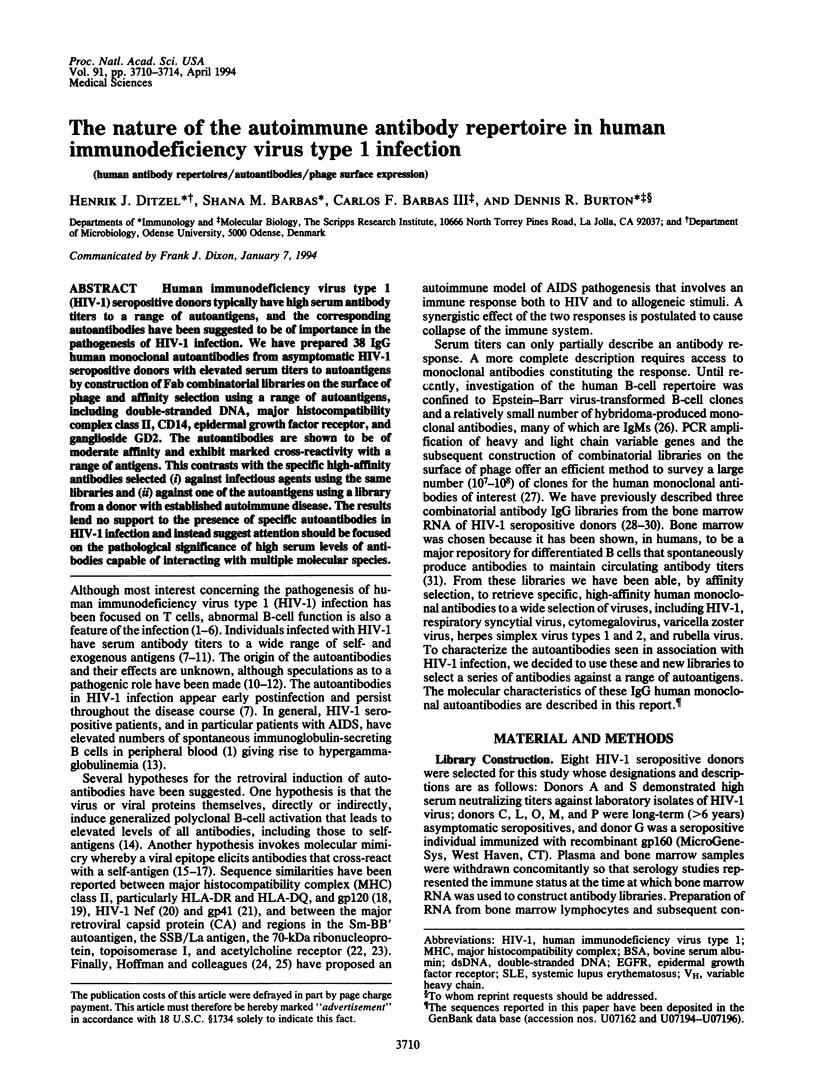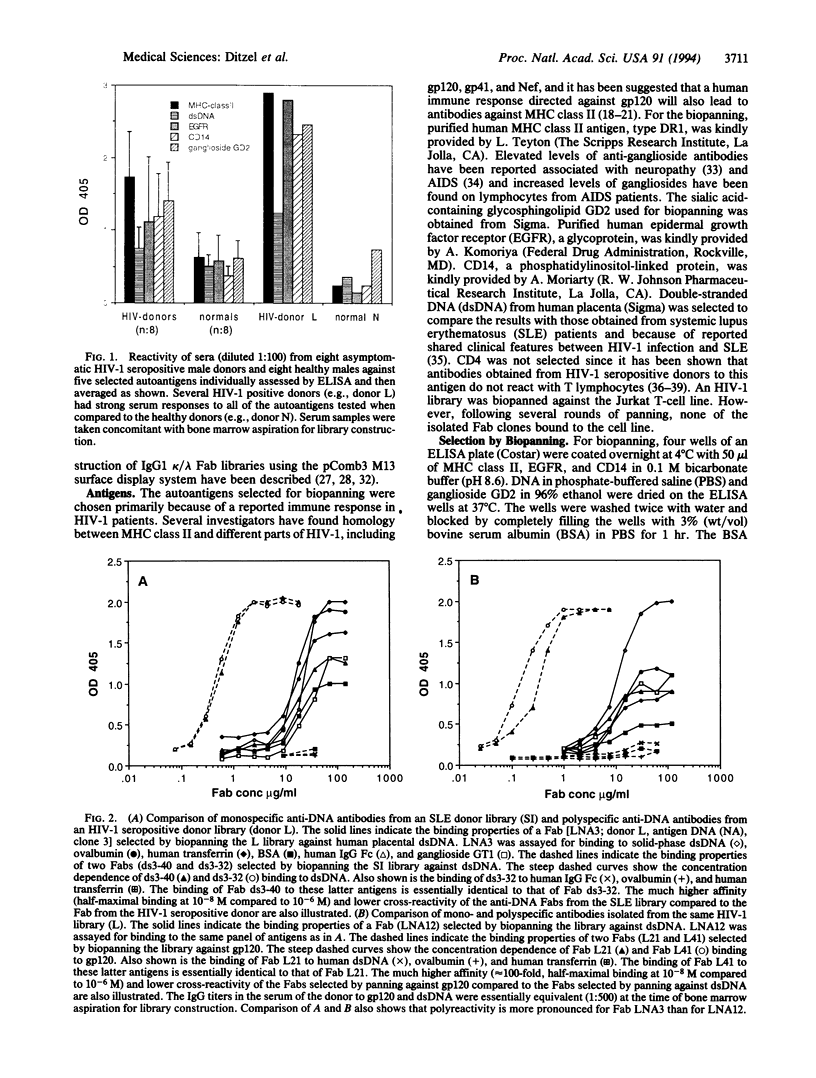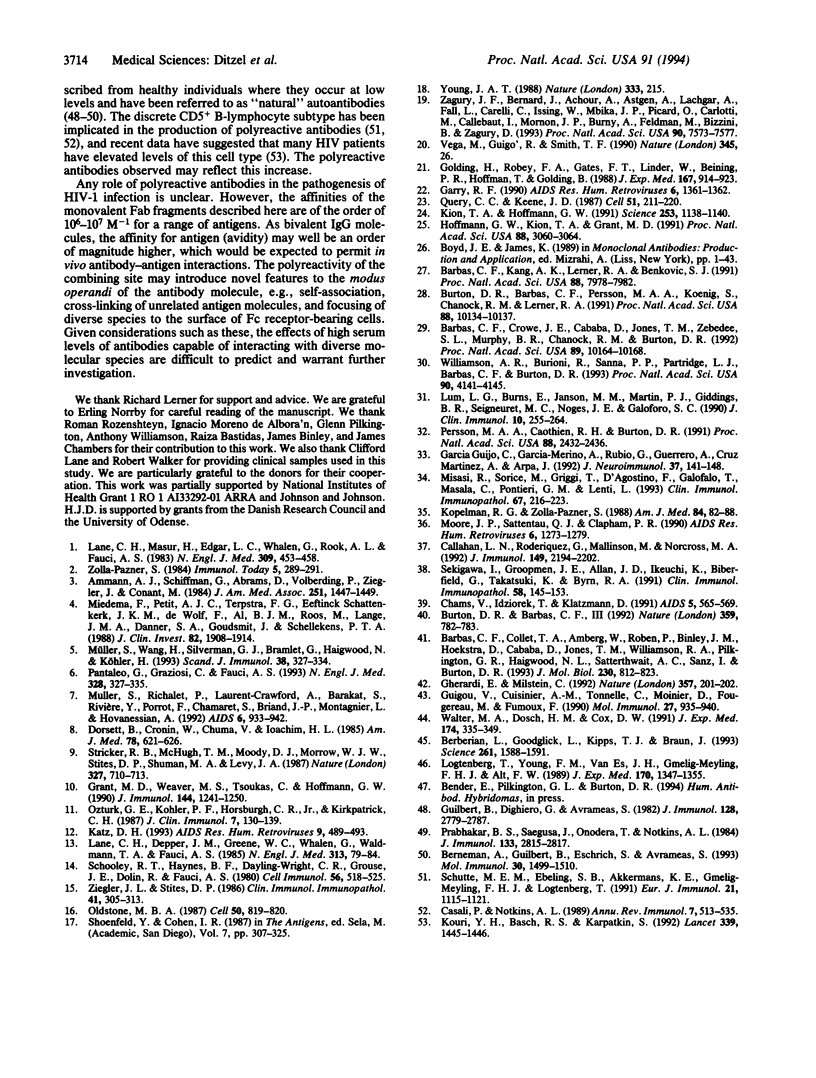Abstract
Human immunodeficiency virus type 1 (HIV-1) seropositive donors typically have high serum antibody titers to a range of autoantigens, and the corresponding autoantibodies have been suggested to be of importance in the pathogenesis of HIV-1 infection. We have prepared 38 IgG human monoclonal autoantibodies from asymptomatic HIV-1 seropositive donors with elevated serum titers to autoantigens by construction of Fab combinatorial libraries on the surface of phage and affinity selection using a range of autoantigens, including double-stranded DNA, major histocompatibility complex class II, CD14, epidermal growth factor receptor, and ganglioside GD2. The autoantibodies are shown to be of moderate affinity and exhibit marked cross-reactivity with a range of antigens. This contrasts with the specific high-affinity antibodies selected (i) against infectious agents using the same libraries and (ii) against one of the autoantigens using a library from a donor with established autoimmune disease. The results lend no support to the presence of specific autoantibodies in HIV-1 infection and instead suggest attention should be focused on the pathological significance of high serum levels of antibodies capable of interacting with multiple molecular species.
Full text
PDF




Images in this article
Selected References
These references are in PubMed. This may not be the complete list of references from this article.
- Ammann A. J., Schiffman G., Abrams D., Volberding P., Ziegler J., Conant M. B-cell immunodeficiency in acquired immune deficiency syndrome. JAMA. 1984 Mar 16;251(11):1447–1449. [PubMed] [Google Scholar]
- Barbas C. F., 3rd, Collet T. A., Amberg W., Roben P., Binley J. M., Hoekstra D., Cababa D., Jones T. M., Williamson R. A., Pilkington G. R. Molecular profile of an antibody response to HIV-1 as probed by combinatorial libraries. J Mol Biol. 1993 Apr 5;230(3):812–823. doi: 10.1006/jmbi.1993.1203. [DOI] [PubMed] [Google Scholar]
- Barbas C. F., 3rd, Crowe J. E., Jr, Cababa D., Jones T. M., Zebedee S. L., Murphy B. R., Chanock R. M., Burton D. R. Human monoclonal Fab fragments derived from a combinatorial library bind to respiratory syncytial virus F glycoprotein and neutralize infectivity. Proc Natl Acad Sci U S A. 1992 Nov 1;89(21):10164–10168. doi: 10.1073/pnas.89.21.10164. [DOI] [PMC free article] [PubMed] [Google Scholar]
- Barbas C. F., 3rd, Kang A. S., Lerner R. A., Benkovic S. J. Assembly of combinatorial antibody libraries on phage surfaces: the gene III site. Proc Natl Acad Sci U S A. 1991 Sep 15;88(18):7978–7982. doi: 10.1073/pnas.88.18.7978. [DOI] [PMC free article] [PubMed] [Google Scholar]
- Berberian L., Goodglick L., Kipps T. J., Braun J. Immunoglobulin VH3 gene products: natural ligands for HIV gp120. Science. 1993 Sep 17;261(5128):1588–1591. doi: 10.1126/science.7690497. [DOI] [PubMed] [Google Scholar]
- Berneman A., Guilbert B., Eschrich S., Avrameas S. IgG auto- and polyreactivities of normal human sera. Mol Immunol. 1993 Nov;30(16):1499–1510. doi: 10.1016/0161-5890(93)90458-n. [DOI] [PubMed] [Google Scholar]
- Boyd J. E., James K. Human monoclonal antibodies: their potential, problems, and prospects. Adv Biotechnol Processes. 1989;11:1–43. [PubMed] [Google Scholar]
- Burton D. R., Barbas C. F., 3rd Antibodies from libraries. Nature. 1992 Oct 29;359(6398):782–783. doi: 10.1038/359782b0. [DOI] [PubMed] [Google Scholar]
- Burton D. R., Barbas C. F., 3rd, Persson M. A., Koenig S., Chanock R. M., Lerner R. A. A large array of human monoclonal antibodies to type 1 human immunodeficiency virus from combinatorial libraries of asymptomatic seropositive individuals. Proc Natl Acad Sci U S A. 1991 Nov 15;88(22):10134–10137. doi: 10.1073/pnas.88.22.10134. [DOI] [PMC free article] [PubMed] [Google Scholar]
- Callahan L. N., Roderiquez G., Mallinson M., Norcross M. A. Analysis of HIV-induced autoantibodies to cryptic epitopes on human CD4. J Immunol. 1992 Sep 15;149(6):2194–2202. [PubMed] [Google Scholar]
- Casali P., Notkins A. L. Probing the human B-cell repertoire with EBV: polyreactive antibodies and CD5+ B lymphocytes. Annu Rev Immunol. 1989;7:513–535. doi: 10.1146/annurev.iy.07.040189.002501. [DOI] [PubMed] [Google Scholar]
- Chams V., Idziorek T., Klatzmann D. Biological properties of anti-CD4 autoantibodies purified from HIV-infected patients. AIDS. 1991 May;5(5):565–569. [PubMed] [Google Scholar]
- Dorsett B., Cronin W., Chuma V., Ioachim H. L. Anti-lymphocyte antibodies in patients with the acquired immune deficiency syndrome. Am J Med. 1985 Apr;78(4):621–626. doi: 10.1016/0002-9343(85)90405-x. [DOI] [PubMed] [Google Scholar]
- Garcia Guijo C., Garcia-Merino A., Rubio G., Guerrero A., Cruz Martinez A., Arpa J. IgG anti-ganglioside antibodies and their subclass distribution in two patients with acute and chronic motor neuropathy. J Neuroimmunol. 1992 Mar;37(1-2):141–148. doi: 10.1016/0165-5728(92)90165-h. [DOI] [PubMed] [Google Scholar]
- Garry R. F. Extensive antigenic mimicry by retrovirus capsid proteins. AIDS Res Hum Retroviruses. 1990 Dec;6(12):1361–1362. doi: 10.1089/aid.1990.6.1361. [DOI] [PubMed] [Google Scholar]
- Gherardi E., Milstein C. Original and artificial antibodies. Nature. 1992 May 21;357(6375):201–202. doi: 10.1038/357201a0. [DOI] [PubMed] [Google Scholar]
- Golding H., Robey F. A., Gates F. T., 3rd, Linder W., Beining P. R., Hoffman T., Golding B. Identification of homologous regions in human immunodeficiency virus I gp41 and human MHC class II beta 1 domain. I. Monoclonal antibodies against the gp41-derived peptide and patients' sera react with native HLA class II antigens, suggesting a role for autoimmunity in the pathogenesis of acquired immune deficiency syndrome. J Exp Med. 1988 Mar 1;167(3):914–923. doi: 10.1084/jem.167.3.914. [DOI] [PMC free article] [PubMed] [Google Scholar]
- Grant M. D., Weaver M. S., Tsoukas C., Hoffmann G. W. Distribution of antibodies against denatured collagen in AIDS risk groups and homosexual AIDS patients suggests a link between autoimmunity and the immunopathogenesis of AIDS. J Immunol. 1990 Feb 15;144(4):1241–1250. [PubMed] [Google Scholar]
- Guigou V., Cuisinier A. M., Tonnelle C., Moinier D., Fougereau M., Fumoux F. Human immunoglobulin VH and VK repertoire revealed by in situ hybridization. Mol Immunol. 1990 Sep;27(9):935–940. doi: 10.1016/0161-5890(90)90161-r. [DOI] [PubMed] [Google Scholar]
- Guilbert B., Dighiero G., Avrameas S. Naturally occurring antibodies against nine common antigens in human sera. I. Detection, isolation and characterization. J Immunol. 1982 Jun;128(6):2779–2787. [PubMed] [Google Scholar]
- Hoffmann G. W., Kion T. A., Grant M. D. An idiotypic network model of AIDS immunopathogenesis. Proc Natl Acad Sci U S A. 1991 Apr 15;88(8):3060–3064. doi: 10.1073/pnas.88.8.3060. [DOI] [PMC free article] [PubMed] [Google Scholar]
- Katz D. H. AIDS: primarily a viral or an autoimmune disease? AIDS Res Hum Retroviruses. 1993 May;9(5):489–493. doi: 10.1089/aid.1993.9.489. [DOI] [PubMed] [Google Scholar]
- Kion T. A., Hoffmann G. W. Anti-HIV and anti-anti-MHC antibodies in alloimmune and autoimmune mice. Science. 1991 Sep 6;253(5024):1138–1140. doi: 10.1126/science.1909456. [DOI] [PubMed] [Google Scholar]
- Kopelman R. G., Zolla-Pazner S. Association of human immunodeficiency virus infection and autoimmune phenomena. Am J Med. 1988 Jan;84(1):82–88. doi: 10.1016/0002-9343(88)90012-5. [DOI] [PubMed] [Google Scholar]
- Kouri Y. H., Basch R. S., Karpatkin S. B-cell subsets and platelet counts in HIV-1 seropositive subjects. Lancet. 1992 Jun 13;339(8807):1445–1446. doi: 10.1016/0140-6736(92)92033-c. [DOI] [PubMed] [Google Scholar]
- Lane H. C., Depper J. M., Greene W. C., Whalen G., Waldmann T. A., Fauci A. S. Qualitative analysis of immune function in patients with the acquired immunodeficiency syndrome. Evidence for a selective defect in soluble antigen recognition. N Engl J Med. 1985 Jul 11;313(2):79–84. doi: 10.1056/NEJM198507113130204. [DOI] [PubMed] [Google Scholar]
- Lane H. C., Masur H., Edgar L. C., Whalen G., Rook A. H., Fauci A. S. Abnormalities of B-cell activation and immunoregulation in patients with the acquired immunodeficiency syndrome. N Engl J Med. 1983 Aug 25;309(8):453–458. doi: 10.1056/NEJM198308253090803. [DOI] [PubMed] [Google Scholar]
- Logtenberg T., Young F. M., Van Es J. H., Gmelig-Meyling F. H., Alt F. W. Autoantibodies encoded by the most Jh-proximal human immunoglobulin heavy chain variable region gene. J Exp Med. 1989 Oct 1;170(4):1347–1355. doi: 10.1084/jem.170.4.1347. [DOI] [PMC free article] [PubMed] [Google Scholar]
- Lum L. G., Burns E., Janson M. M., Martin P. J., Giddings B. R., Seigneuret M. C., Noges J. E., Galoforo S. C. IgG anti-tetanus toxoid antibody synthesis by human bone marrow. I. Two distinct populations of marrow B cells and functional differences between marrow and peripheral blood B cells. J Clin Immunol. 1990 Sep;10(5):255–264. doi: 10.1007/BF00916701. [DOI] [PubMed] [Google Scholar]
- Miedema F., Petit A. J., Terpstra F. G., Schattenkerk J. K., de Wolf F., Al B. J., Roos M., Lange J. M., Danner S. A., Goudsmit J. Immunological abnormalities in human immunodeficiency virus (HIV)-infected asymptomatic homosexual men. HIV affects the immune system before CD4+ T helper cell depletion occurs. J Clin Invest. 1988 Dec;82(6):1908–1914. doi: 10.1172/JCI113809. [DOI] [PMC free article] [PubMed] [Google Scholar]
- Misasi R., Sorice M., Griggi T., d'Agostino F., Garofalo T., Masala C., Pontieri G. M., Lenti L. GM3 as a target of anti-lymphocytic ganglioside antibodies in AIDS patients. Clin Immunol Immunopathol. 1993 Jun;67(3 Pt 1):216–223. doi: 10.1006/clin.1993.1068. [DOI] [PubMed] [Google Scholar]
- Moore J. P., Sattentau Q. J., Clapham P. R. Enhancement of soluble CD4-mediated HIV neutralization and gp 120 binding by CD4 autoantibodies and monoclonal antibodies. AIDS Res Hum Retroviruses. 1990 Nov;6(11):1273–1279. doi: 10.1089/aid.1990.6.1273. [DOI] [PubMed] [Google Scholar]
- Muller S., Richalet P., Laurent-Crawford A., Barakat S., Rivière Y., Porrot F., Chamaret S., Briand J. P., Montagnier L., Hovanessian A. Autoantibodies typical of non-organ-specific autoimmune diseases in HIV-seropositive patients. AIDS. 1992 Sep;6(9):933–942. doi: 10.1097/00002030-199209000-00004. [DOI] [PubMed] [Google Scholar]
- Müller S., Wang H., Silverman G. J., Bramlet G., Haigwood N., Köhler H. B-cell abnormalities in AIDS: stable and clonally-restricted antibody response in HIV-1 infection. Scand J Immunol. 1993 Oct;38(4):327–334. doi: 10.1111/j.1365-3083.1993.tb01734.x. [DOI] [PubMed] [Google Scholar]
- Oldstone M. B. Molecular mimicry and autoimmune disease. Cell. 1987 Sep 11;50(6):819–820. doi: 10.1016/0092-8674(87)90507-1. [DOI] [PubMed] [Google Scholar]
- Ozturk G. E., Kohler P. F., Horsburgh C. R., Jr, Kirkpatrick C. H. The significance of antilymphocyte antibodies in patients with acquired immune deficiency syndrome (AIDS) and their sexual partners. J Clin Immunol. 1987 Mar;7(2):130–139. doi: 10.1007/BF00916007. [DOI] [PubMed] [Google Scholar]
- Pantaleo G., Graziosi C., Fauci A. S. New concepts in the immunopathogenesis of human immunodeficiency virus infection. N Engl J Med. 1993 Feb 4;328(5):327–335. doi: 10.1056/NEJM199302043280508. [DOI] [PubMed] [Google Scholar]
- Persson M. A., Caothien R. H., Burton D. R. Generation of diverse high-affinity human monoclonal antibodies by repertoire cloning. Proc Natl Acad Sci U S A. 1991 Mar 15;88(6):2432–2436. doi: 10.1073/pnas.88.6.2432. [DOI] [PMC free article] [PubMed] [Google Scholar]
- Prabhakar B. S., Saegusa J., Onodera T., Notkins A. L. Lymphocytes capable of making monoclonal autoantibodies that react with multiple organs are a common feature of the normal B cell repertoire. J Immunol. 1984 Dec;133(6):2815–2817. [PubMed] [Google Scholar]
- Query C. C., Keene J. D. A human autoimmune protein associated with U1 RNA contains a region of homology that is cross-reactive with retroviral p30gag antigen. Cell. 1987 Oct 23;51(2):211–220. doi: 10.1016/0092-8674(87)90148-6. [DOI] [PubMed] [Google Scholar]
- Schooley R. T., Haynes B. F., Payling-Wright C. R., Grouse J. E., Dolin R., Fauci A. S. Mechanism of Epstein-Barr virus-induced human B-lymphocyte activation. Cell Immunol. 1980 Dec;56(2):518–525. doi: 10.1016/0008-8749(80)90126-4. [DOI] [PubMed] [Google Scholar]
- Schutte M. E., Ebeling S. B., Akkermans K. E., Gmelig-Meyling F. H., Logtenberg T. Antibody specificity and immunoglobulin VH gene utilization of human monoclonal CD5+ B cell lines. Eur J Immunol. 1991 May;21(5):1115–1121. doi: 10.1002/eji.1830210505. [DOI] [PubMed] [Google Scholar]
- Sekigawa I., Groopmen J. E., Allan J. D., Ikeuchi K., Biberfield G., Takatsuki K., Byrn R. A. Characterization of autoantibodies to the CD4 molecule in human immunodeficiency virus infection. Clin Immunol Immunopathol. 1991 Jan;58(1):145–153. doi: 10.1016/0090-1229(91)90156-5. [DOI] [PubMed] [Google Scholar]
- Stricker R. B., McHugh T. M., Moody D. J., Morrow W. J., Stites D. P., Shuman M. A., Levy J. A. An AIDS-related cytotoxic autoantibody reacts with a specific antigen on stimulated CD4+ T cells. 1987 Jun 25-Jul 1Nature. 327(6124):710–713. doi: 10.1038/327710a0. [DOI] [PubMed] [Google Scholar]
- Walter M. A., Dosch H. M., Cox D. W. A deletion map of the human immunoglobulin heavy chain variable region. J Exp Med. 1991 Aug 1;174(2):335–349. doi: 10.1084/jem.174.2.335. [DOI] [PMC free article] [PubMed] [Google Scholar]
- Williamson R. A., Burioni R., Sanna P. P., Partridge L. J., Barbas C. F., 3rd, Burton D. R. Human monoclonal antibodies against a plethora of viral pathogens from single combinatorial libraries. Proc Natl Acad Sci U S A. 1993 May 1;90(9):4141–4145. doi: 10.1073/pnas.90.9.4141. [DOI] [PMC free article] [PubMed] [Google Scholar]
- Young J. A. HIV and HLA similarity. Nature. 1988 May 19;333(6170):215–215. doi: 10.1038/333215c0. [DOI] [PubMed] [Google Scholar]
- Zagury J. F., Bernard J., Achour A., Astgen A., Lachgar A., Fall L., Carelli C., Issing W., Mbika J. P., Picard O. Identification of CD4 and major histocompatibility complex functional peptide sites and their homology with oligopeptides from human immunodeficiency virus type 1 glycoprotein gp120: role in AIDS pathogenesis. Proc Natl Acad Sci U S A. 1993 Aug 15;90(16):7573–7577. doi: 10.1073/pnas.90.16.7573. [DOI] [PMC free article] [PubMed] [Google Scholar]
- Ziegler J. L., Stites D. P. Hypothesis: AIDS is an autoimmune disease directed at the immune system and triggered by a lymphotropic retrovirus. Clin Immunol Immunopathol. 1986 Dec;41(3):305–313. doi: 10.1016/0090-1229(86)90001-2. [DOI] [PubMed] [Google Scholar]



